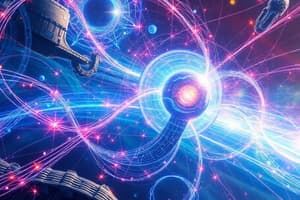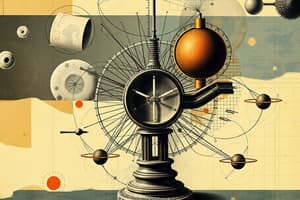Podcast
Questions and Answers
What is the formula for kinetic energy?
What is the formula for kinetic energy?
- KE = mgh
- KE = 1/2 mv² (correct)
- KE = mv
- KE = 1/2 mgh
Which law states that for every action there is an equal and opposite reaction?
Which law states that for every action there is an equal and opposite reaction?
- Third Law of Motion (correct)
- First Law of Motion
- Second Law of Motion
- Law of Universal Gravitation
What is the relationship described by Ohm's Law?
What is the relationship described by Ohm's Law?
- V = I * R²
- V = I + R
- V = I / R
- V = IR (correct)
Which law describes that energy cannot be created or destroyed?
Which law describes that energy cannot be created or destroyed?
What phenomenon describes motion where restoring force is proportional to displacement?
What phenomenon describes motion where restoring force is proportional to displacement?
What principle states that the entropy of an isolated system always increases?
What principle states that the entropy of an isolated system always increases?
Which of the following terms refers to the bending of light due to gravity as described in General Relativity?
Which of the following terms refers to the bending of light due to gravity as described in General Relativity?
Which concept represents the transfer of energy through a medium?
Which concept represents the transfer of energy through a medium?
Flashcards are hidden until you start studying
Study Notes
Key Concepts in Physics
1. Mechanics
- Kinematics: Study of motion without considering forces.
- Displacement, velocity, acceleration.
- Dynamics: Study of forces and their effect on motion.
- Newton's Laws of Motion:
- An object at rest stays at rest; an object in motion stays in motion unless acted upon.
- Force equals mass times acceleration (F=ma).
- For every action, there is an equal and opposite reaction.
- Newton's Laws of Motion:
- Energy:
- Kinetic Energy (KE) = 1/2 mv²
- Potential Energy (PE) = mgh
- Conservation of Energy principle.
2. Thermodynamics
- Laws of Thermodynamics:
- Energy cannot be created or destroyed, only transformed.
- Entropy of an isolated system always increases.
- As temperature approaches absolute zero, the entropy of a perfect crystal approaches zero.
- Heat Transfer:
- Conduction, convection, radiation.
3. Waves and Oscillations
- Waves: Transfer of energy through a medium.
- Types: Mechanical (sound), electromagnetic (light), matter waves.
- Properties: Wavelength, frequency, amplitude, speed.
- Oscillations: Repeated motion around an equilibrium position.
- Simple harmonic motion (SHM): Motion where restoring force is proportional to displacement.
4. Electricity and Magnetism
- Electric Charge: Fundamental property of matter.
- Like charges repel, unlike charges attract.
- Ohm's Law: V = IR (Voltage = Current x Resistance).
- Magnetic Fields: Produced by moving charges; represented by field lines.
- Electromagnetic Induction: Generation of electric current by changing magnetic fields (Faraday's Law).
5. Modern Physics
- Theory of Relativity:
- Special Relativity: Time dilation, length contraction, mass-energy equivalence (E=mc²).
- General Relativity: Gravity as curvature of spacetime.
- Quantum Mechanics:
- Wave-particle duality, uncertainty principle, quantum entanglement.
- Fundamental particles: Quarks, leptons, bosons.
6. Astrophysics and Cosmology
- Big Bang Theory: Origin of the universe from a singular point.
- Black Holes: Regions of spacetime with gravitational pull so strong that nothing can escape.
- Dark Matter and Dark Energy: Components of the universe affecting its expansion and structure.
Fundamental Units
- SI Units:
- Length: Meter (m)
- Mass: Kilogram (kg)
- Time: Second (s)
- Electric Current: Ampere (A)
- Temperature: Kelvin (K)
- Amount of Substance: Mole (mol)
- Luminous Intensity: Candela (cd)
Important Formulas
- Kinematics:
- v = u + at
- s = ut + 1/2 at²
- v² = u² + 2as
- Work and Energy:
- Work (W) = Force (F) x Distance (d) x cos(θ)
- Charge:
- Coulomb's Law: F = k(q₁q₂/r²)
Problem-Solving Strategies
- Identify knowns and unknowns.
- Apply relevant formulas.
- Consider units and conversions.
- Check for consistency in results.
Mechanics
- Kinematics: Analyzes motion by focusing on displacement, velocity, and acceleration without involving forces.
- Dynamics: Investigates how forces influence motion, summarized by Newton's Laws of Motion.
- Newton's Laws:
- An object remains at rest or in uniform motion unless acted upon.
- The relationship between force and motion is given by F = ma.
- For every action, there is an equal and opposite reaction.
- Energy Types:
- Kinetic Energy (KE) calculated as 1/2 mv².
- Potential Energy (PE) determined by mgh.
- Energy conservation states that energy cannot be created or destroyed; it only changes forms.
Thermodynamics
- Laws of Thermodynamics:
- Energy transformation is permissible; it cannot be created or destroyed.
- Entropy in an isolated system always increases over time.
- Entropy of a perfect crystal approaches zero as temperature nears absolute zero.
- Heat Transfer Methods:
- Conduction, convection, and radiation explain how heat moves through materials.
Waves and Oscillations
- Waves: Mechanisms for transferring energy via mediums; include mechanical (sound), electromagnetic (light), and matter waves.
- Wave Properties: Wavelength, frequency, amplitude, and speed are essential characteristics of waves.
- Oscillations: Characterized by repetitive motion around an average position; simple harmonic motion (SHM) occurs when the restoring force is directly proportional to the displacement from this position.
Electricity and Magnetism
- Electric Charge: A fundamental attribute of matter with like charges repelling and unlike charges attracting.
- Ohm's Law: Establishes the relationship between voltage (V), current (I), and resistance (R) expressed as V = IR.
- Magnetic Fields: Generated by moving charges, these fields can be represented visually through field lines.
- Electromagnetic Induction: Describes how a change in magnetic fields produces electric current, known through Faraday's Law.
Modern Physics
- Theory of Relativity:
- Special Relativity: Introduces time dilation, length contraction, and mass-energy equivalence (E=mc²).
- General Relativity: Defines gravity as the curvature of spacetime influenced by mass.
- Quantum Mechanics: Explores phenomena like wave-particle duality, the uncertainty principle, and quantum entanglement.
- Fundamental Particles: Includes quarks, leptons, and bosons, which are building blocks of matter.
Astrophysics and Cosmology
- Big Bang Theory: Explains the universe's formation from a singular point approximately 13.8 billion years ago.
- Black Holes: Regions where gravitational forces are so intense that nothing, including light, can escape from them.
- Dark Matter and Dark Energy: Mysterious components of the universe that influence its expansion and structure.
Fundamental Units
- SI Units:
- Length: Meter (m)
- Mass: Kilogram (kg)
- Time: Second (s)
- Electric Current: Ampere (A)
- Temperature: Kelvin (K)
- Amount of Substance: Mole (mol)
- Luminous Intensity: Candela (cd)
Important Formulas
- Kinematics:
- v = u + at (final velocity)
- s = ut + 1/2 at² (displacement)
- v² = u² + 2as (velocity relation)
- Work and Energy: Work (W) = Force (F) x Distance (d) x cos(θ) describes how force acts over distance.
- Charge Interaction: Coulomb's Law, expressed as F = k(q₁q₂/r²), defines the force between two charges.
Problem-Solving Strategies
- Clearly identify known quantities and unknown variables.
- Utilize appropriate formulas relevant to the problem.
- Ensure correct units and perform necessary conversions.
- Validate results by checking for logical consistency.
Studying That Suits You
Use AI to generate personalized quizzes and flashcards to suit your learning preferences.




